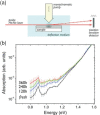Current Status of Outdoor Lifetime Testing of Organic Photovoltaics
- PMID: 30128250
- PMCID: PMC6096983
- DOI: 10.1002/advs.201800434
Current Status of Outdoor Lifetime Testing of Organic Photovoltaics
Abstract
Performance degradation is one of the key obstacles limiting the commercial application of organic photovoltaic (OPV) devices. The assessment of OPV stability and lifetime are usually based on simulated degradation experiments conducted under indoor conditions, whereas photovoltaic devices experience different environmental conditions under outdoor operation. Besides the intrinsic degradation of OPV devices due to the evolution of optoelectronic and morphological structure during long-term operation, outdoor environmental changes can impose extra stresses and accelerate the degradation of OPV modules. Although outdoor studies on long-term OPV stability are restricted by the long data collection times, they provide direct information on OPV stability under mixed degradation stresses and are therefore invaluable from the point of view of both research and practical application. Here, an overview of the current status of outdoor lifetime studies of OPVs is provided. After a summary of device lifetime extrapolated from indoor studies, outdoor lifetime testing platforms are introduced and the operational lifetime of various OPV devices are reviewed. The influence of climate and weather parameters on device performance and burn-in phenomena observed during the degradation of OPVs is then discussed. Finally, an outlook and directions for future research in this field are suggested.
Keywords: lifetime; organic photovoltaics; outdoor; stability; test protocols.
Figures














References
-
- Darling S. B., You F., RSC Adv. 2013, 3, 17633.
-
- a) Li S., Ye L., Zhao W., Zhang S., Mukherjee S., Ade H., Hou J., Adv. Mater. 2016, 28, 9423; - PubMed
- b) Liu Z. K., Sun Y. X., Yuan J. Y., Wei H. X., Huang X. D., Han L., Wang W. W., Wang H. Q., Ma W. L., Adv. Mater. 2013, 25, 5772; - PubMed
- c) Tan Z. A., Zhang W. Q., Zhang Z. G., Qian D. P., Huang Y., Hou J. H., Li Y. F., Adv. Mater. 2012, 24, 1476; - PubMed
- d) Ma W. L., Yang C. Y., Gong X., Lee K., Heeger A. J., Adv. Funct. Mater. 2005, 15, 1617;
- e) Gao L., Zhang Z.‐G., Bin H., Xue L., Yang Y., Wang C., Liu F., Russell T. P., Li Y., Adv. Mater. 2016, 28, 8288; - PubMed
- f) Lin Y., Wang J., Zhang Z.‐G., Bai H., Li Y., Zhu D., Zhan X., Adv. Mater. 2015, 27, 1170; - PubMed
- g) Li G., Chang W.‐H., Yang Y., Nat. Rev. Mater. 2017, 2, 17043;
- h) Zhao W., Li S., Yao H., Zhang S., Zhang Y., Yang B., Hou J., J. Am. Chem. Soc. 2017, 139, 7148. - PubMed
-
- Green M. A., Prog. Photovoltaics 2009, 17, 183.
-
- a) Jorgensen M., Norrman K., Gevorgyan S. A., Tromholt T., Andreasen B., Krebs F. C., Adv. Mater. 2012, 24, 580; - PubMed
- b) Lee J. U., Jung J. W., Jo J. W., Jo W. H., J. Mater. Chem. 2012, 22, 24265;
- c) Gevorgyan S. A., Madsen M. V., Roth B., Corazza M., Hösel M., Søndergaard R. R., Jørgensen M., Krebs F. C., Adv. Energy Mater. 2016, 6, 1501208;
- d) Gevorgyan S. A., Heckler I. M., Bundgaard E., Corazza M., Hösel M., Søndergaard R. R., Benatto G. A. D. R., Jørgensen M., Krebs F. C., J. Phys. D: Appl. Phys. 2017, 50, 103001;
- e) Espinosa N., Zimmermann Y., dos Reis Benatto G. A., Lenz M., Krebs F. C.. Energy Environ. Sci. 2016, 9, 1674.
Publication types
LinkOut - more resources
Full Text Sources
Other Literature Sources
